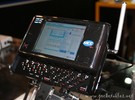Korean Linux MID boasts digital-TV
Jan 11, 2008 — by Eric Brown — from the LinuxDevices Archive — 6 views A non-profit Korean government-funded research organization has demonstrated a prototype mobile Internet device (MID) based on its Qplus embedded Linux distro. Korea-based Electronics and Telecommunications Research Institute's (ETRI's) “Mobile Convergence Communicator” (MCC) boasts 802.11b/g and 3.5G cellular… networking, along with digital TV reception and Bluetooth.
A non-profit Korean government-funded research organization has demonstrated a prototype mobile Internet device (MID) based on its Qplus embedded Linux distro. Korea-based Electronics and Telecommunications Research Institute's (ETRI's) “Mobile Convergence Communicator” (MCC) boasts 802.11b/g and 3.5G cellular… networking, along with digital TV reception and Bluetooth.
ETRI has yet to make a formal announcement of the MCC, but a handheld technology site called Pocketables showed off some photos and basic specs this week. According to the site, the MCC was designed with ETRI's Esto GUI development software which is built on top of its open source, Red Hat-flavored Qplus distribution, first introduced in 2002, but now upgraded to Linux 2.6. More on Qplus and Esto can be found below, and a circa-2002 review of Qplus can be found here.








ETRI's MCC
(Source: Pocketables.net
The MCC connects via built-in 802.11b/g WiFi, or via a built-in “3.5G” HSDPA (high-speed downlink packet access) modem claimed capable of 7.2Mbps download speeds. The presence of cellular data networking invites comparison with Nokia's Linux-based N810, which is slated to gain WiMax later this year.
Compared to the N810, the ETRI device offers a faster clock speed, but an older architecture. It has a Marvell PXA270 based on a 624MHz ARM9 core, compared to the N810's Texas Instruments OMAP 2420, based on a 400MHz ARM11 core. The MCC has a slightly richer complement of memory, though, with 64MB of NOR in addition to 256MB of NAND Flash. (Read about NAND vs. NOR flash). The N810 has a higher-resolution display, but a lower-resolution camera. The MCC lacks the N810's built-in GPS receiver, but likely supports external Bluetooth GPS units.
Otherwise, the two WiFi-enabled devices are similar, down to the slide-up screen that reveals a keyboard. According to the story, the MCC provides the following features:
- Processor — 624MHz Marvell PXA270
- Memory — 128MB SDRAM, 64MB NOR Flash, 256MB NAND
- Flash Expansion — MiniSD card slot
- Display — 3.5-inch TFT touchscreen (640 x 480, 260K colors)
- Graphics: 2D/3D graphic accelerator (2700G5)
- USB: 1 x host; 1 x client
- Wireless: HSDPA, 802.11b/g WiFi, Bluetooth 1.2, T-DMB
- Camera: 2-megapixel CMOS
- Battery: 4.2V 2000mAh li-ion
- Installed mobile software services: entertainment, broadcasting, location awareness, and co-browsing
Qplus is comprised of a reconfigurable embedded Linux kernel, system libraries, a graphic window system, and a target builder. It is said to provide:
- Real-time, low-power, optimization, and fast-boot related patches
- Lightweight embedded GUI based on freedesktop and GTK
- Embedded file system optimized for multimedia applications
- Media player and web browser for embedded system
- Fast configuration and deploy using Target Builder
- Fine-grained setup for kernel and packages
- Auto dependency check and size minimization
- Target system image optimization and footprint estimation
Running on QPlus is Esto, a visual software development kit that is said to include project-based source editing, cross-compilation, remote execution, remote and nonstop debugging, and JTAG-based on-chip debugging.
ETRI, located in Taejeon, Korea, is best known for contributing to CDMA (Code-Division Multiple Access) mobile phone technology.
The full pocketables story is available here
This article was originally published on LinuxDevices.com and has been donated to the open source community by QuinStreet Inc. Please visit LinuxToday.com for up-to-date news and articles about Linux and open source.